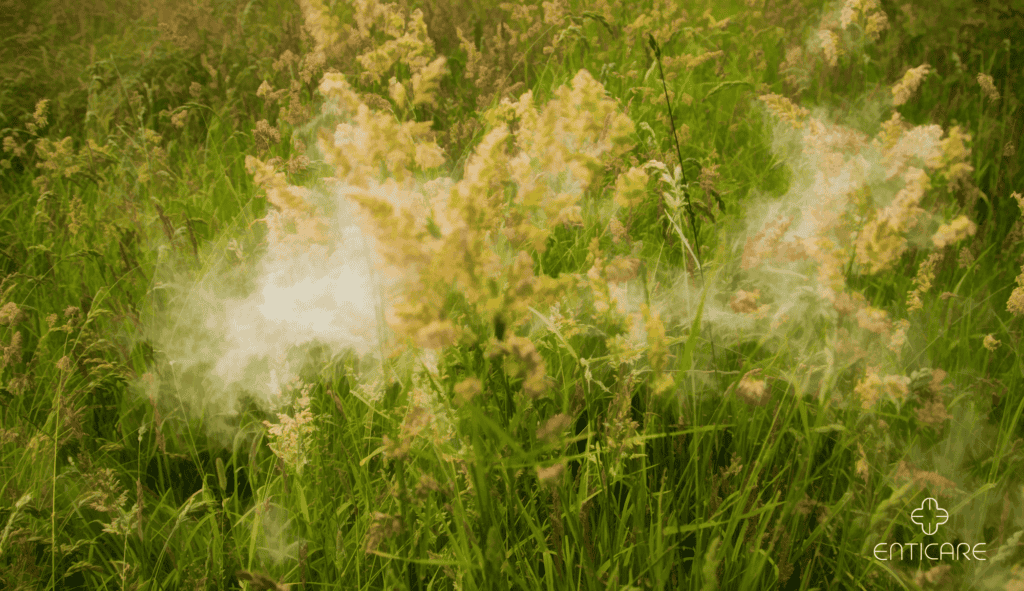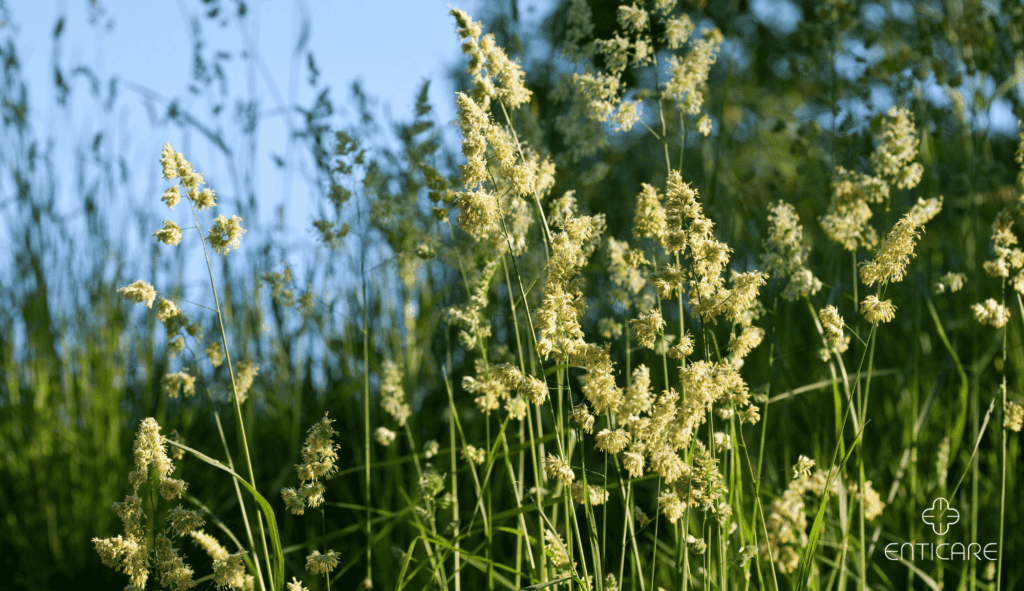Allergic reactions to grass pollen, a type of grass allergy, affect millions of people each year, triggering symptoms that range from mild discomfort to severe reactions. Understanding the causes, identifying the symptoms, and learning about effective treatments can make a significant difference in managing this common allergy. Whether you’re experiencing itchy eyes or relentless sneezing, this blog will guide you through the key steps in controlling your grass pollen allergy.
Understanding Grass Pollen Allergies
Grass pollen is a common cause of grass allergies, affecting many people during the spring and summer months when grasses release their pollen into the air. This type of allergy, known as hay fever or allergic rhinitis, occurs when your immune system overreacts to harmless substances like grass pollen. Grass pollen allergies are most prevalent during the pollen season.
How Grass Pollen Causes Allergies
Grass pollen contains proteins that trigger an immune response in some individuals. When you inhale the pollen, your immune system mistakenly identifies it as a harmful invader and produces antibodies to attack it. This allergic reaction leads to the release of histamine, which causes inflammation and the typical allergy symptoms.
Common Types of Grasses
Not all grasses produce allergenic pollen. However, common culprits include Bermuda grass, Kentucky bluegrass, ryegrass, and Timothy grass. These grasses release pollen that can travel long distances, leading to symptoms even if you’re not near a grassy area.
These grasses are common triggers for allergic rhinitis.
Why Some People Are More Susceptible
Genetics plays a significant role in determining who develops grass pollen allergies. If one or both of your parents have allergies, your risk of developing a grass pollen allergy increases significantly. Additionally, individuals with asthma or eczema are more likely to experience grass pollen allergy symptoms. Individuals with asthma symptoms are more likely to experience severe reactions to grass pollen.
Recognizing Grass Pollen Allergy Symptoms
Recognizing grass allergy symptoms, such as nasal congestion, can help you take action quickly. These symptoms often overlap with other allergic reactions, making it important to identify whether pollen is the trigger.
Nasal Symptoms
Grass pollen primarily affects your respiratory system. Symptoms like nasal congestion, a runny nose, a stuffy nose, sneezing, and postnasal drip are common during peak pollen seasons. These symptoms can mimic the common cold, but if they persist for several weeks or worsen outdoors, grass pollen might be to blame.
Eye Symptoms
Allergic conjunctivitis, or eye inflammation, is a frequent symptom of grass pollen allergies. You may experience red, watery, and itchy eyes during high pollen seasons. Prolonged exposure can also lead to puffiness around the eyes, making you feel uncomfortable throughout the day.
Respiratory Symptoms
Grass pollen allergies can worsen asthma symptoms, leading to coughing, wheezing, shortness of breath, and chest tightness. If you’re already managing asthma, a grass pollen allergy can increase the frequency and severity of asthma attacks, especially during peak pollen months.

Diagnosis and Testing for Grass Pollen Allergies
To manage grass pollen allergies effectively, an accurate diagnosis is crucial. An allergy test can help determine whether grass pollen is the primary trigger for your symptoms, and a visit to an allergy specialist will provide further insights.
Allergy Skin Test
One of the most common methods for diagnosing grass pollen allergies is an allergy skin test. Your doctor will apply a small amount of grass pollen extract to your skin and observe for any allergic reactions, such as redness, swelling, or itching, within 15-20 minutes.
Blood Test
For individuals who cannot undergo a skin test, blood tests like the ImmunoCAP-specific IgE test measure the level of IgE antibodies in response to grass pollen allergens. This test can help confirm your grass pollen allergy and its severity.
Tracking Symptoms
Before seeking professional testing, you can track your symptoms of grass and note when they appear. If your symptoms consistently worsen during the spring or summer months, especially after spending time outdoors, this pattern can suggest a grass pollen allergy.
Effective Treatments for Grass Pollen Allergies
If you have been diagnosed with a grass pollen allergy, several grass allergy treatment options, including nasal sprays, can help relieve your symptoms. Some treatments focus on reducing your body’s reaction to allergens, while others aim to manage the symptoms.
Over-the-Counter Medications
Antihistamines, decongestants, and nasal corticosteroids are commonly used to treat the symptoms of grass pollen allergies. Antihistamines block the action of histamines, reducing symptoms like itching and sneezing. Nasal sprays, including nasal corticosteroids, help reduce inflammation in the nasal passages, providing relief from congestion.
Allergy Shots (Immunotherapy)
Allergy shots, or immunotherapy, offer a long-term solution for severe grass pollen allergies. Over time, these injections help your body build tolerance to allergens by introducing small amounts of the allergen. This approach can reduce the severity of symptoms and improve your overall quality of life.
Natural Remedies
For those who prefer natural treatments, saline nasal rinses can help remove pollen from your nasal passages. Additionally, consuming local honey or using air purifiers can potentially minimize your exposure to pollen and reduce allergic reactions.

Preventing Grass Pollen Exposure
While medication and treatment offer relief, the best way to manage grass pollen allergies is to monitor pollen counts and minimize your exposure during the pollen season. With careful planning and some lifestyle changes, you can reduce your symptoms and enjoy the outdoors.
Check Daily Pollen Counts
Before heading outside during pollen season, check local pollen counts through apps or weather reports. On high pollen days, limit your outdoor activities or plan them for early morning or late afternoon when pollen levels are typically lower.
Keep Indoor Air Clean
Close windows and doors to prevent pollen from entering your home. Use air conditioning instead of fans, and consider investing in HEPA air filters to reduce pollen levels indoors. Regularly vacuum carpets and upholstery to eliminate pollen that may have settled indoors.
Shower and Change Clothes After Being Outdoors
After spending time outside, especially on high pollen days, shower to remove pollen from your skin and hair. Change your clothes to avoid spreading pollen indoors. This simple routine can help prevent ongoing exposure and minimize symptoms like a runny nose and other allergic reactions.
Take Control of Your Grass Pollen Allergy
Grass pollen allergies can significantly affect your quality of life, but you don’t have to suffer in silence. By identifying the symptoms, getting the right diagnosis, and implementing effective treatments, you can manage your allergies and enjoy the outdoors without fear.
Don’t let grass pollen allergies disrupt your life. Schedule an appointment with one of our allergy specialists today to get personalized advice and treatment options that work for you. Click here to book your appointment and take the first step toward better allergy management.


